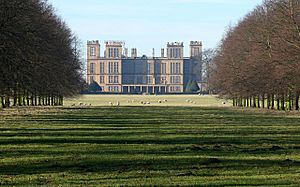William Cavendish, 1st Duke of Devonshire facts for kids
Quick facts for kids
The Duke of Devonshire
|
|
|---|---|

Portrait by Godfrey Kneller
|
|
| Lord Steward of the Household | |
| In office 1689–1707 |
|
| Preceded by | The Duke of Ormond |
| Succeeded by | William Cavendish, 2nd Duke of Devonshire |
| Lord High Steward for the Coronation of Queen Anne |
|
| In office 22 April 1702 – 23 April 1702 |
|
| Preceded by | The Baron Somers |
| Succeeded by | The Duke of Grafton |
| Personal details | |
| Born | 25 January 1640 |
| Died | 18 August 1707 (aged 67) |
| Spouse | Lady Mary Butler (m. 1662) |
| Children | Lady Elizabeth Cavendish William Cavendish, 2nd Duke of Devonshire Lord Henry Cavendish Lord James Cavendish |
| Parents | William Cavendish, 3rd Earl of Devonshire Elizabeth Cavendish, Countess of Devonshire |

William Cavendish, 1st Duke of Devonshire (born January 25, 1640 – died August 18, 1707) was an important English soldier and politician. He was a member of the Whig political party. He served in the House of Commons (a part of the English Parliament) from 1661. Later, he inherited his father's title as Earl of Devonshire in 1684 and moved to the House of Lords. Cavendish was one of the "Immortal Seven". This group invited William of Orange to become king during the Glorious Revolution. For his help, he was made the first Duke of Devonshire in 1694.
Contents
Early Life and Political Career
William Cavendish was the son of William Cavendish, 3rd Earl of Devonshire. His mother was Lady Elizabeth Cecil. After finishing his education, he traveled around Europe. In 1661, he was chosen to be a Member of Parliament for Derbyshire.
He was a Whig politician during the reigns of Charles II of England and James II of England. He became a leader of the group in the House of Commons that opposed the King's court and Catholic influence. He was known as Lord Cavendish at this time. In 1678, he helped create charges against the King's chief financial officer, Lord Danby.
He was re-elected to Parliament several times. King Charles II made him a privy councillor, which meant he advised the King. However, Cavendish soon left this role. He felt that Catholic interests were becoming too strong in the government. He also spoke out against the King's advisors. He even offered to help his friend, Lord Russell, escape from prison.
Life at Chatsworth and Hardwick
The famous thinker Thomas Hobbes spent his last years living at Chatsworth House. This grand home belonged to the Cavendish family. Hobbes died at another Cavendish family estate, Hardwick Hall, in December 1679. He had been a friend of the family for a long time, even tutoring an earlier William Cavendish.
In 1684, William Cavendish became the Earl of Devonshire after his father passed away. He then took his seat in the House of Lords. He disagreed with some of the actions of King James II. At one point, he was fined a large sum of money after an argument. He was briefly held in prison because he could not pay.
After this, the Earl went to Chatsworth House. He spent his time building a new, grand mansion there. Famous artists like William Talman, Antonio Verrio, James Thornhill, and Grinling Gibbons helped with its design and decorations.
Role in the Glorious Revolution
Cavendish strongly supported the "Glorious Revolution" of 1688. This event brought William III of Orange to the throne of England. Cavendish was one of the "Immortal Seven" who signed the invitation for William to come to England. After William became King, Cavendish was given the Order of the Garter, a special honor.
After the revolution, Cavendish was a leading Whig politician. He served as William's Lord Steward, a high-ranking official. In 1694, he was given the title of Duke of Devonshire and also Marquess of Hartington. These titles were given to him to recognize his important services to the country. His last public duty was helping to create the union with Scotland. This agreement joined England and Scotland into one kingdom.
Family Life
William Cavendish married Lady Mary Butler in 1662. She was the daughter of James Butler, 1st Duke of Ormonde. They had four children together:
- Lady Elizabeth Cavendish (1670–1741)
- William Cavendish, 2nd Duke of Devonshire (around 1672–1729)
- Lord Henry Cavendish (1673–1700)
- Lord James Cavendish (died 1751)
See also
 In Spanish: William Cavendish (1640-1707) para niños
In Spanish: William Cavendish (1640-1707) para niños


